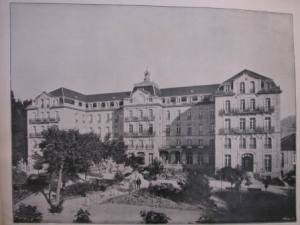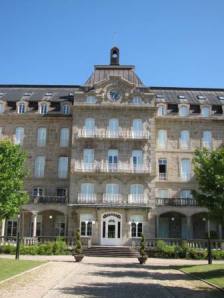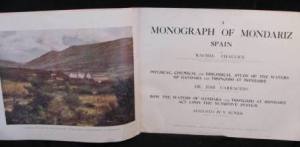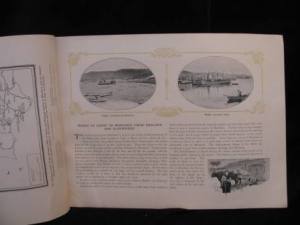I’ve already confessed my rather expensive obsession with early 20th-century English-language writing on Spain. This summer, one of my projects was to track down a particular, very obscure book by one of the writers I’m researching for my new project. I knew from a scattered range of sources that early in the 20th century, the scholar and translator Rachel Challice had put together a large, illustrated album, designed to attract English readers to the Galician spa town of Mondariz Balneario. The album, listed by the Biblioteca Nacional as Monograph of Mondaris [sic] and dated by them to 1906, is held by very few other libraries and shows up in fewer than half a dozen Google links. Obviously I could have waited for an opportunity to go and look at the copy in Madrid, but where’s the fun in that? When a copy came up on a collectors’ site, I negotiated a 10% discount, and eventually got it for … gulp … a low 3-figure sum. And now it’s mine! (Except for pages 11 and 12, which are unaccountably absent…)
The album fills in some important pieces of the puzzle I’m piecing together in my new project on the commercial and cultural networks connecting England and Galicia in the early 20th century. Rachel Challice is almost entirely forgotten now, but in the decade before her death in 1909, she was a well-known writer on Spain, also familiar to English readers as the translator of the popular Spanish novelist Armando Palacio Valdés. She was something of an entrepreneuse too, and owner of Challice’s Spanish Information Bureau, which operated out of Great Winchester Street in central London. Challice put together the Monograph in collaboration with the Peinador brothers, Enrique and Ramón who ran the Hydropathic establishment at Mondariz; they had previously published a Spanish-language album, which Challice draws on for the sumptuous illustrations, and for the two accompanying essays by medical doctors, outlining the science behind the waters. The text of the main section, however, is written by Challice herself, and evidently with a clear eye not only on her assigned mission of attracting English travellers to the Peinadors’ establishment, but also on promoting the Spanish Information Bureau as ‘the only authorised British agency’ for wholesale orders of Mondariz mineral water (17).
 The album does a great job of showing off the luxurious accommodations and extensive range of activities available at the Hydropathic Establishment; Challice knows her audience, and she knows the principal fears English travellers had about Galicia at that point, most of them dating back to George Borrow’s 1842 account of his time dodging banditti, conmen and corrupt hoteliers, in The Bible in Spain. She stresses the luxury, convenience and comfort of the accommodations, the elegant and nutritious menus, and the convenience of the travel network set up to convey guests the 13 miles from Vigo, where most international travellers landed, to Mondariz – in the process providing plugs for two of the other companies involved in the promotion of Galicia to English travellers, the Royal Mail Steam Packet Company and the Booth Steamship Line.* All these efforts seem to have paid off – the vast majority of subsequent English travellers to Galicia (or at least those who left a record of their travels) called at Mondariz, and those who travelled with the Booth Line, at least, seem to have been inspired to give it a more favourable writeup than the rival establishment at La Toja, some 20 miles away on the coast.
The album does a great job of showing off the luxurious accommodations and extensive range of activities available at the Hydropathic Establishment; Challice knows her audience, and she knows the principal fears English travellers had about Galicia at that point, most of them dating back to George Borrow’s 1842 account of his time dodging banditti, conmen and corrupt hoteliers, in The Bible in Spain. She stresses the luxury, convenience and comfort of the accommodations, the elegant and nutritious menus, and the convenience of the travel network set up to convey guests the 13 miles from Vigo, where most international travellers landed, to Mondariz – in the process providing plugs for two of the other companies involved in the promotion of Galicia to English travellers, the Royal Mail Steam Packet Company and the Booth Steamship Line.* All these efforts seem to have paid off – the vast majority of subsequent English travellers to Galicia (or at least those who left a record of their travels) called at Mondariz, and those who travelled with the Booth Line, at least, seem to have been inspired to give it a more favourable writeup than the rival establishment at La Toja, some 20 miles away on the coast.
 Mondariz today is rather a different proposition to the place Rachel Challice helped to promote a century ago. The resort’s decline during the 20th century came to a head with a devastating fire in 1972, which destroyed many of the buildings. In the last few years, the main hotel building has been restored as apartments and a new hotel has opened just across the road, and despite the overwhelming tranquillity, it’s just about possible to imagine the place in its heyday. Part of my project over the next year or so will be to trace as many English-language accounts of that heyday as I can, to understand what Mondariz and the Hydropathic Establishment meant for the business and cultural networks running between Galicia and England in the early 20th century. The Spanish Information Bureau never got to play a major role in those networks: Rachel Challice died suddenly in 1909, just as Galicia was taking off as a destination for British travellers, and her contribution has largely been forgotten. Her album, though, is an elegant personal testament to an entrepreneurial and intellectual woman. And the pictures are fabulous!
Mondariz today is rather a different proposition to the place Rachel Challice helped to promote a century ago. The resort’s decline during the 20th century came to a head with a devastating fire in 1972, which destroyed many of the buildings. In the last few years, the main hotel building has been restored as apartments and a new hotel has opened just across the road, and despite the overwhelming tranquillity, it’s just about possible to imagine the place in its heyday. Part of my project over the next year or so will be to trace as many English-language accounts of that heyday as I can, to understand what Mondariz and the Hydropathic Establishment meant for the business and cultural networks running between Galicia and England in the early 20th century. The Spanish Information Bureau never got to play a major role in those networks: Rachel Challice died suddenly in 1909, just as Galicia was taking off as a destination for British travellers, and her contribution has largely been forgotten. Her album, though, is an elegant personal testament to an entrepreneurial and intellectual woman. And the pictures are fabulous!
* This last detail allows us to date the album to later than the BNE’s suggestion of 1906, given that the Booth Line only began calling regularly at Vigo in early 1909. I think it’s likely that Challice researched and wrote the album during her year-long stay in Spain in 1907, although I still need to verify this.



[…] I suffer from a slight addiction to early 20th-century writing on Spain, which has, on occasion, proved fairly expensive. Sometimes, though, obsessively searching on AbeBooks or Antiqbook can throw up some unexpected […]
[…] Am now in Galicia for a flying visit, and hoping the Vigo airport bookshop (such as it is…) will provide some additional evidence when I pass back through on Wednesday. Before then, though, I have five libros de oro (visitor books for the spa at Mondariz, where I am currently in residence) to look through, in which I am very hopeful of finding at least one signature from our old friend Rachel Challice. […]
[…] carriage. While he missed his primary target, a number of guards and bystanders were killed. Our old friend Rachel Challice, who visited the couple the following year, writes in The Secret History of the […]
[…] royal wedding and the quite spectacular wave of opportunistic literary toadying it provoked, more Hispanophile entrepreneurs, more tourism history (don’t you just love the Booth Line postcard at the top of the […]
[…] more Anglo-Spanish Edwardians will be coming this way very soon – starting with an update on the entrepreneuse and publicist Miss Rachel Challice, and continuing with more of the elusive, eccentric, and totally enchanting characters I’ve […]